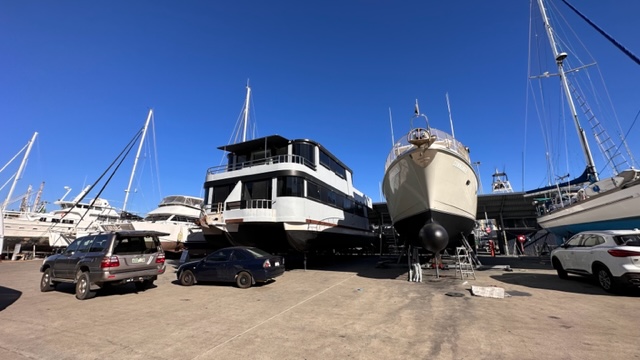The Importance of Anti-Fouling for Houseboats

When it comes to keeping The Prestige and other houseboats in top-notch condition, one crucial maintenance task is anti-fouling. This process involves taking the houseboat out of the water to remove accumulated marine growth and apply protective coatings. In this post, we’ll delve into why anti-fouling is essential for boats and how it helps ensure optimal performance and longevity.
The Battle Against Marine Growth
Spending prolonged periods in water exposes boats to a variety of marine organisms, including algae, barnacles, and mollusks. These unwelcome guests can attach themselves to the hull, creating a layer of marine growth. Over time, this buildup not only affects the aesthetic appeal of the boat but also has significant consequences for its performance.
Impact on Performance

- Increased Drag: Marine growth on the hull creates additional surface area, increasing drag as the boat moves through the water. This resistance can lead to decreased speed, reduced fuel efficiency, and increased operating costs.
- Impaired Maneuverability: Excessive fouling can hamper the boat’s maneuverability, making steering and handling more challenging. This compromise in control can be dangerous, especially in tight spaces or adverse weather conditions.
- Weight Gain: Marine growth adds unnecessary weight to the boat, affecting its buoyancy and stability. This can lead to a decrease in overall performance and potentially compromise safety.
Protection Against Corrosion
Apart from the performance issues, marine growth can also accelerate the corrosion process. Certain organisms produce acidic secretions that can damage the hull’s protective coatings, leading to metal deterioration. Anti-fouling treatments provide a protective barrier that prevents direct contact between the hull and the corrosive elements present in the marine environment.
The Anti-Fouling Process

- Hauling Out: The first step in the anti-fouling process is hauling The Prestige houseboat out of the water onto a hard stand. This allows for a thorough inspection of the hull, rudder, and propellers, identifying any damage or areas in need of repair.
- Cleaning and Preparation: Once out of the water, the hull is meticulously cleaned to remove all traces of marine growth, using methods such as high-pressure water blasting or scraping. This step ensures a clean and smooth surface for the application of anti-fouling coatings.
- Applying Anti-Fouling Coatings: Anti-fouling paints and coatings are specially formulated to deter marine organisms from adhering to the boat’s surface. These coatings contain biocides that discourage fouling and provide long-lasting protection. Different types of anti-fouling coatings are available, catering to specific needs and environmental considerations.
- Regular Maintenance: Anti-fouling is not a one-time solution. To maintain its effectiveness, it’s essential to adhere to a regular maintenance schedule. The frequency of reapplication will depend on various factors such as the type of anti-fouling used, water conditions, and the boat’s usage.

